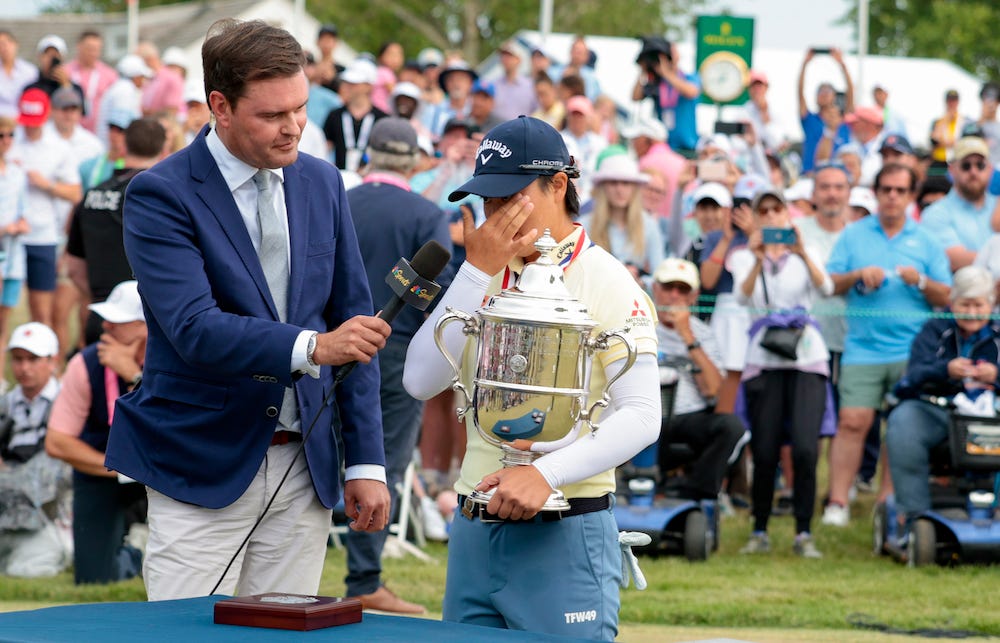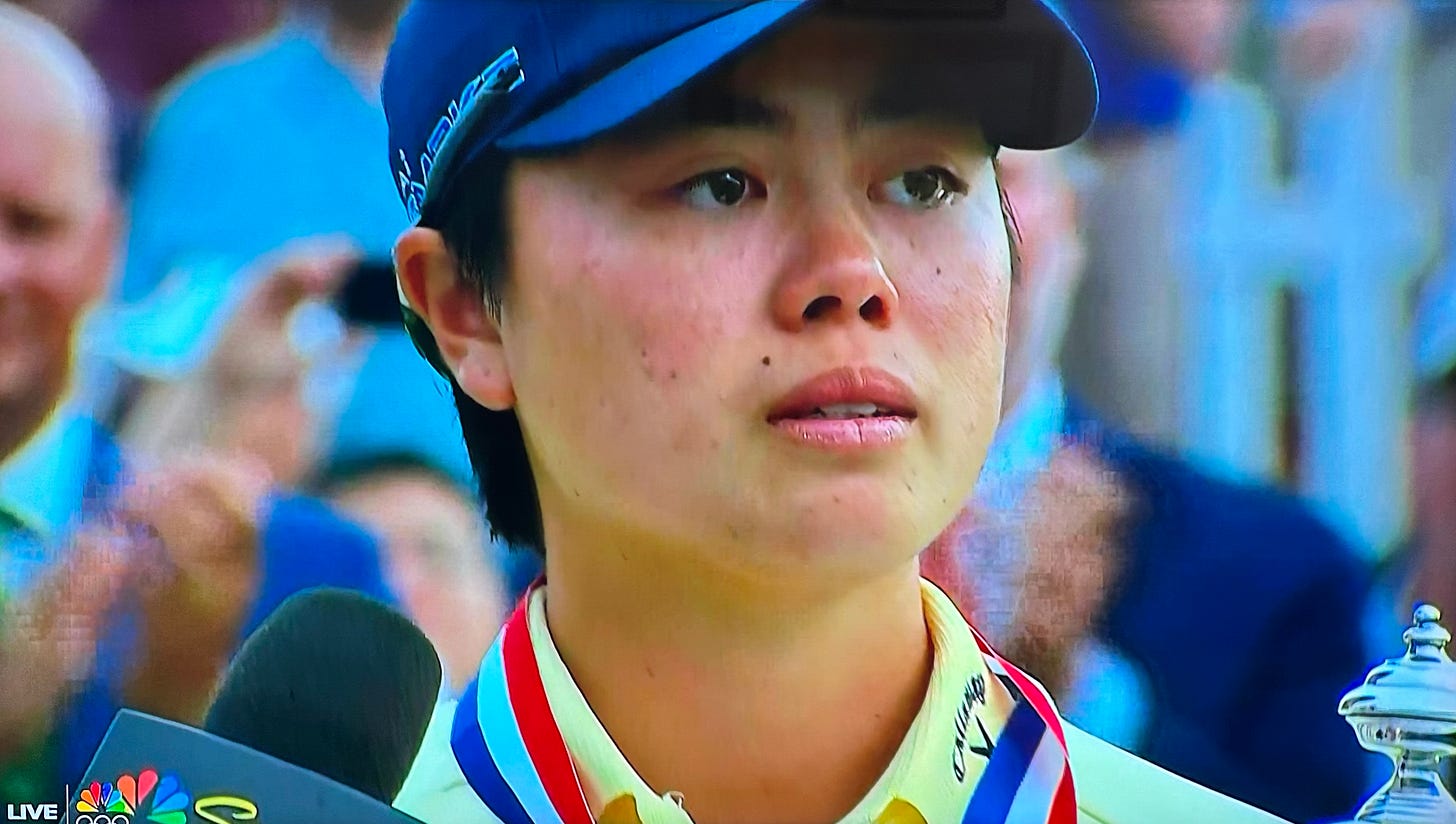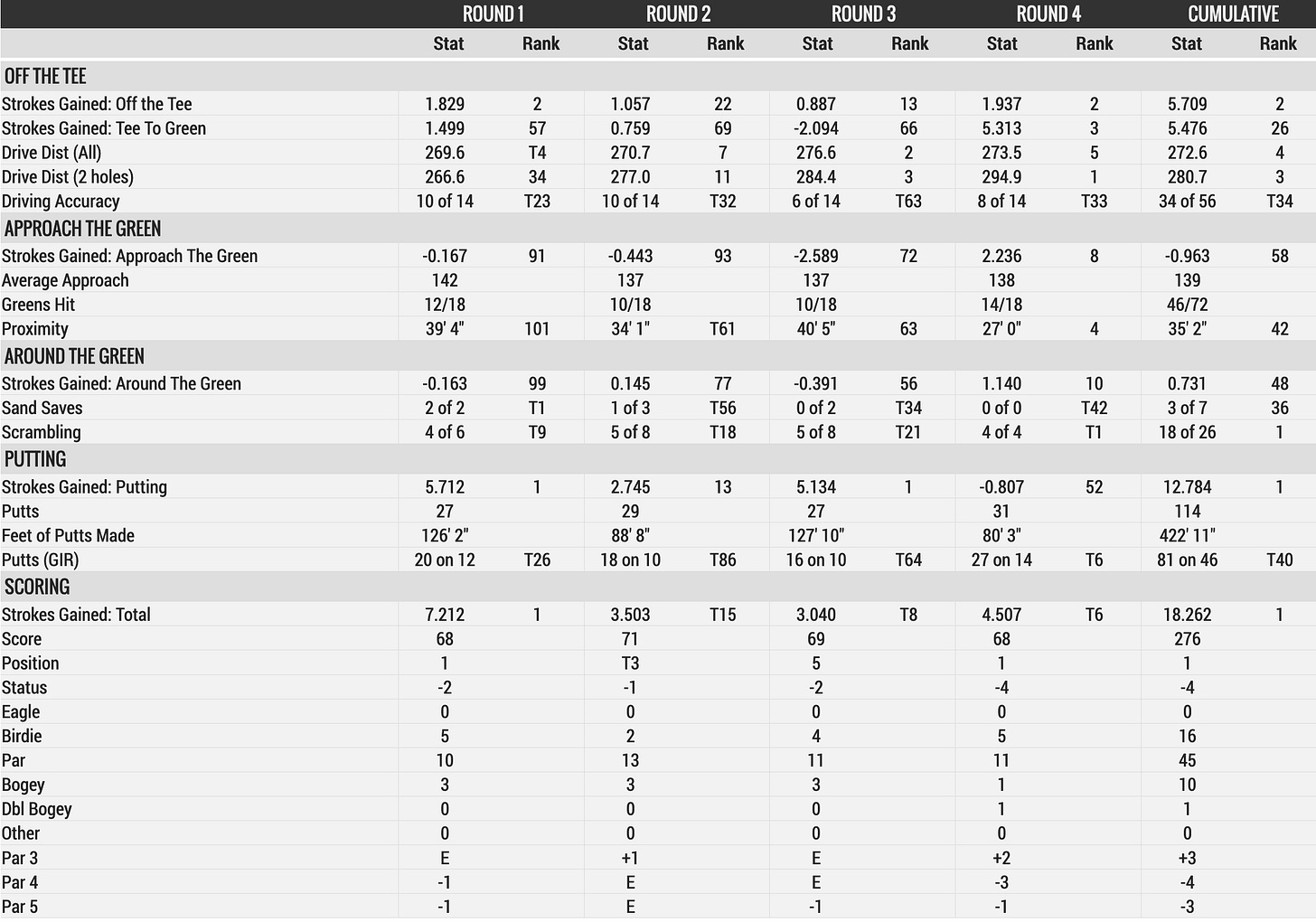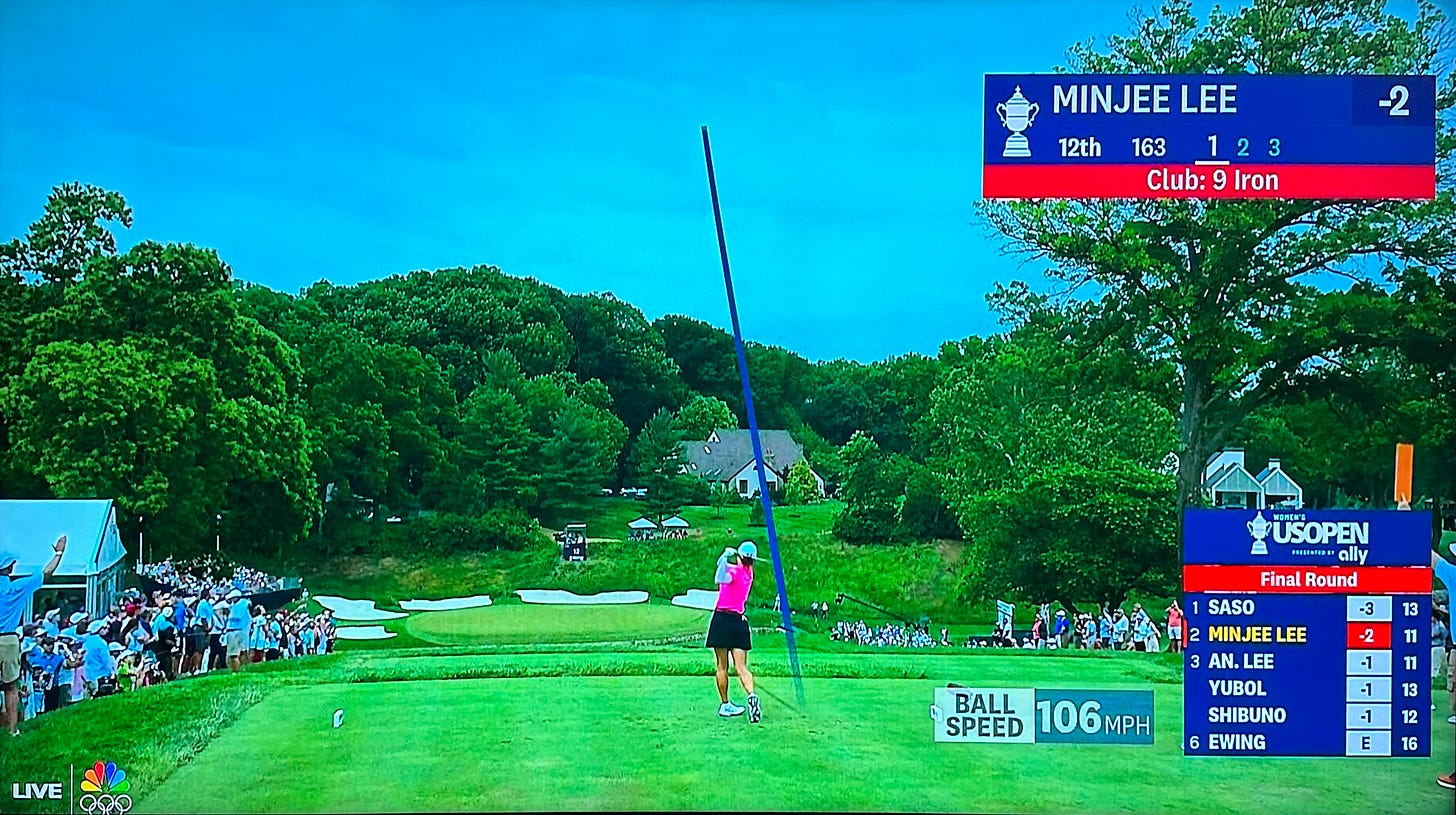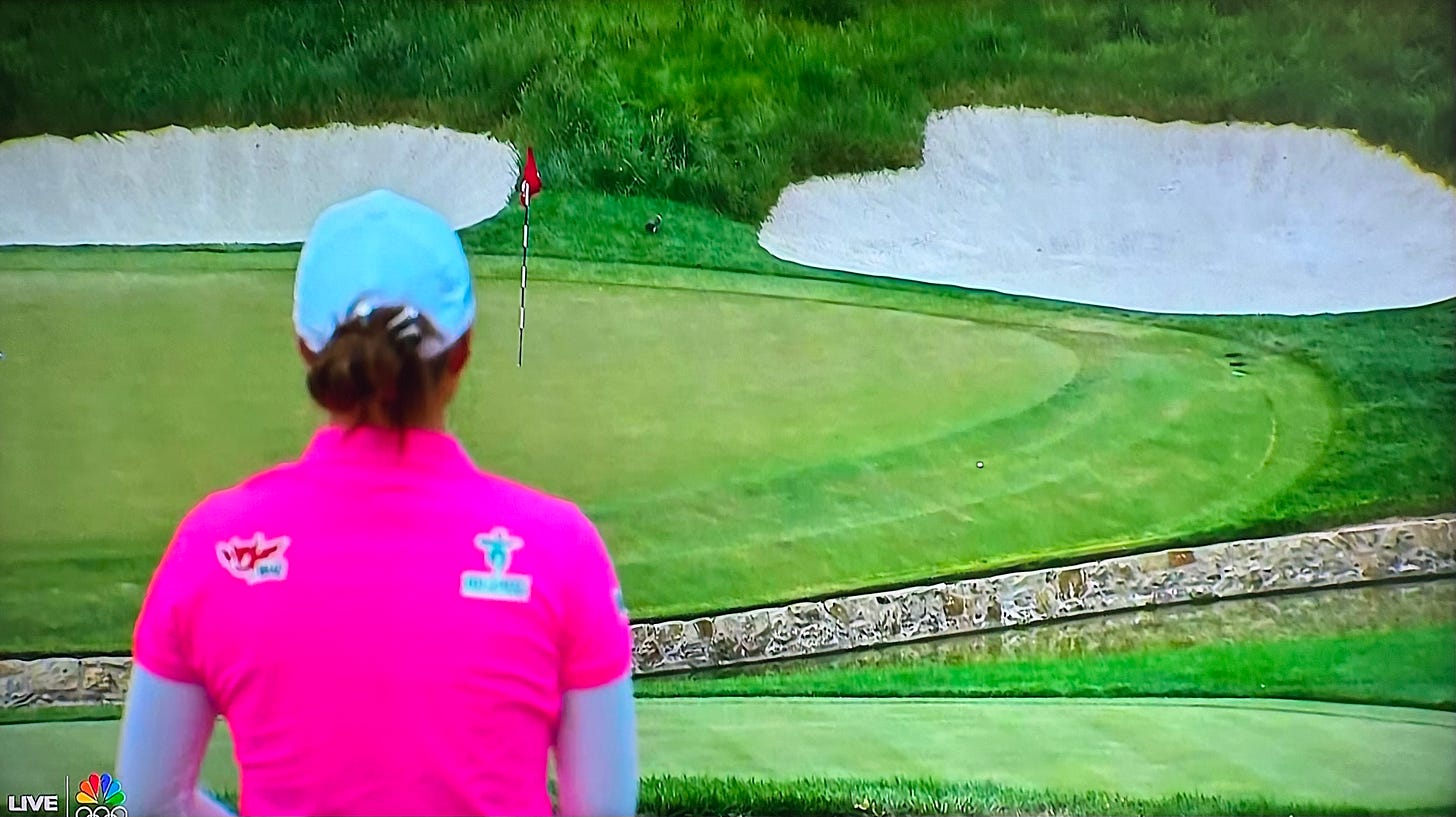2 At 22: Saso Wins Second U.S. Women's Open
Leaders collapse under Lancaster CC's relentless test. Plus, the 12th hole's place in major lore, MacIntyre wins in Canada, and three more Open spots claimed at Hamilton.

With a golf swing to kill for and the disposition of a world-beater well beyond her 22 years, Yuka Saso has somehow not won in the three years since her U.S. Women’s Open breakthrough victory at Olympic Club. Entering the week, there was no reason to think Saso would contend at Lancaster Country Club given a 2024 record of fine-but-rarely-singular play: T16-T17-T27-T13-T9-T30-T29-MC.
But the player who now represents Japan after hailing from the Phillippines in her first victory, quietly warmed up to a difficult test. One which, despite being about as far from Lombard Street and Olympic Club as possible, shares a key similarity to where Saso first broke through: old school golf sporting hilly, uneven stances. Throw in her otherworldly swing, a bizarre early week display of putting mastery before giving way to a clutch Sunday of fairways-and-greens, and it all adds up to history: Saso became the first player in USGA history to win the U.S. Women’s Open Presented by Ally on multiple occasions for two different countries.
While her county of choice is a nice tribute to her parents—mom is from the Philippines and dad is from Japan—the semantics only matter in the context of the Olympic Games. In terms of winning the biggest and most lucrative event in women’s golf, Saso’s parental homage means little compared to the remarkable final round 68 posted as a trio of third-round leaders fizzled under U.S. Women’s Open pressure.
Minjee Lee, Wichanee Meechai and Andrea Lee faded so badly that they were surpassed by 2019 AIG Women’s British Open champion Hinako Shibuno and Ally Ewing. At least third-round co-leader Andrea Lee salvaged a tie for third.
Also of note: qualifier Arpichaya Yubol of Thailand posted a final day 69 to finish solo fifth at +1, 281.
Ewing’s final round 66 tied low score for the week on a golf course that reminded the golf world what it looks like when players face a tough setup armed with ballstriking distances in proportion to the design. It was tough, ugly at times, but ultimately a beautiful reminder of what a major should look like. The best player over four days was able to stand out.
Through 63 holes the championship appeared to be Minjee Lee’s to lose. The 2022 champion at Pine Needles opened her day with birdie before showing signs of stress and little of the acumen she’d displayed after a back nine 33 on Saturday. The 28-year-old Australian and two-time major champ struggled before a full unraveling at Lancaster’s graveyard of champions, a.k.a. the par 3 12th. That’s where an Amen Corner-esque moment unfolded as Lee played at the pin, lost her tee shot a bit right playing at a green situated at an angle, and saw her ball roll back into the creek (more below).
With a final round 78 Minjee Lee finished ninth at 283.
Saso, who had matched Inbee Park as the U.S. Women’s Open youngest champion in 2021 when surviving a playoff at 19 years, 11 months and 17 days, has now become the youngest to win multiple U.S. Women’s Open, surpassing two all-time greats: Hollis Stacy and Mickey Wright.
“It feels great,” Saso said at the trophy ceremony. “I think winning in 2021 I represented the Philippines. I feel like I was able to give back to my mom. This year I was able to represent Japan, and I think I was able to give back to my dad. I'm very happy that I was able to do it. It's just a wonderful feeling that I was able to give back to my parents in the same way.”

Here’s the strangest part of Saso’s win: she’d mastered Lancaster’s steeply-pitched Flynn greens for three rounds. All while scraping it around a course that was even more of a star than in 2015 when it last hosted the U.S. Women’s Open.
As Saso’s fairways-and-greens game returned Sunday to give her putting prowess a break, a double-bogey at the par 3 sixth came after—yep—a four-putt.
Saso nearly repeated that nightmare at the par 3 17th. With the championship seemingly in her pocket, the week’s leader in strokes gained putting hit her 25-footer a whopping ten feet by and had to make a 3’5” putt for bogey. It almost erased a brilliant stretch where the player with a Rory McIlroy-inspired swing played the 12th through 16th holes four-under-par under to dust the field.
Saso was oblivious to what the leaders were doing as she hit 14 of 18 greens Sunday. The two putting debacles notwithstanding, her ballstriking took some of the pressure off a putter that carried her to a -2 total through 54 holes and three back of the third-round leaders.
“I'm not sure how the other players played,” Sato said. “I wasn't looking at the scoreboard. I wasn't too relaxed to be able to see the scoreboard. But like I said earlier, I just tried to be focused on my routine and my game, and I think that's why I looked like that on TV. I think it's a good thing that I looked like that.”
With Shibuno’s final round 72, Sunday marked the first time in any major championship—men or women—that Japanese players went 1-2.
Thanks to Ally and the USGA’s hard push over the last five years to accelerate women’s purses forward, Saso takes home $2.4 million for first place while Shibuno takes home $1.3 million.
The final leaderboard:
Saso By The Numbers
I’m too lazy to type and I also think it’s fun to see Saso’s wild progression from round to round—courtesy of the PGA Tour’s ShotLink the USGA mercifully now has at their Opens.
Note Saso’s change in approach play (SG 91-93-72-8), tee-to-green (57-69-66-3), and putting (1-13-1-52). It’s a silly, silly game.
But she delivered in the clutch to ultimately prove that stats matter—up to a point.
If you’re wondering whether Saso’s +3 on the par 3’s was unusual, it was not.
Shibuno was +4 on the par 3s, Ewing was even par, Andrea Lee +4, and Arpichaya was +5.
Low Am: Three-Way Tie
The battle for low-amateur honors ended with a three-way tie between reigning U.S. Amateur champion Megan Schofill, 2024 U.S. Women’s Amateur Four-Ball champion and Drive, Chip and Putt standout Asterisk Talley, and USC sophomore Catherine Park.
Hole Of The Week: 12th

Official Yardage: 181
Scoring Average (Rank): 3.484 (1st)
Aces: 0
Birdies: 41
Pars: 253
Bogeys: 94
Double Bogeys: 55
Others: 17
Field Score: +223
Green in regulation: 268/461 (58.31% (8th))
Proximity: 32’0” (8th)
Sand saves: 11/40 (27.5% (5th))
Scrambling: 53/193 (27.46% (1st))]
Average putts: 1.948 (10th)
Three putts: 36 (6th)
The downhill 12th will go down in major championship lore for luring Nelly Korda into a disastrous 10 and quick exit after being the pre-championship favorite. Yet the 181-yarder also played an outsized role in Sunday’s final round.
Eventual champion Yuka Saso arrived at the hole 1-under-par and charging at then-leader Minjee Lee. A tee shot to 10’7” kicked off a run of four birdies in five holes.
Moments after Saso’s birdie, Andrea Lee was at 1-under-par but played safely to the 16 feet from the hole. She wisely avoided the perils of a severely tilted green and a subtle angle that made Sunday’s final round pin placement mirror the dynamics of Augusta National’s 12th.
Playing partner Minjee Lee, then -2 and very much in the event despite being +3 for the round, played at the hole and lost her shot a touch right. Because of the fronting slope and slight angle to the green, Minjee watched her ball roll back into a fronting creek that greeted 92 balls over four rounds.
NBC was all over capturing the hole from all angles, including the side view giving us a sense of the green slope as well as the incredible camera shot from over Lee’s shoulder where viewers could watch the ball trickle back into the water.
Was the hole goofy? No.
Tough? Yes. And probably made to look excessively difficult because of a shaved bank that highlighted some questionable player decisions.
Had the USGA treated the front bank as maintained rough, the steepness would have sent balls into the creek less dramatically. And Nelly Korda might not have tried to punch one or two of her wedges into the tight-mow slope leading to her weird unraveling Thursday.
In case you missed it, Mel Reid did an incredible job explaining the early play issues and solidified her place as the next great player-turned-TV-analyst (when she’s ready to go into TV work full-time.)
Lancaster CC By The Numbers
Sadly, the USGA is all booked up for U.S. Women’s Open Presented by Ally sites through 2036—pausing here to let you giggle—so the brilliant all-around test that was Lancaster Country Club is not likely to host the women unless a scheduled site realizes it has no chance of replicating LCC’s beautiful merging of golf and galleries.
Either way, the course stats show the par 3’s ranked 9th, 3rd, 1st, and 8th in difficulty:
It’s a magnificent course that all should be proud of. Shout outs to original architect William Flynn, restoring architect Jim Nagle, director of grounds Josh Saunders, superintendent Matt Wolffe, the USGA’s Shannon Rouillard for a sound setup, and the crew/members who sacrificed to give the women such a dreamy stage to shine.
MacIntyre Wins RBC Canadian Open
After summoning his dad from Scotland to loop, Robert MacIntyre captured his maiden PGA Tour victory at the RBC Canadian Open. He became the fifth player this season converting a 54-hole lead into a victory.
This one was extra sweet with his dad on the bag after the Scotsman has had trouble finding a compatible luggage handler or comfort playing in the United States since moving to Florida.
The 27-year-old also played his way into the U.S. Open and signature events should he choose. He is projected to move to No. 39 in the Official World Golf Ranking, securing a spot in the U.S. Open at Pinehurst. (A major he was scheduled to attempt to qualify for on Monday.)
MacIntyre had his share of pursuers on a bizarre, foggy Sunday at the Martin Ebert-revamped Hamilton Golf and Country Club. The haunting clubhouse and 18th’s amphitheater setting once again created one of the PGA Tour’s most cinematic finishes.
Well, unless you count the drones bothering the champion.
“If it didn't go away, I was going to start throwing my clubs at it,” the neurotic Scot MacIntyre said of CBS’s live drones that have failed to bother any other player to date. “That's how annoyed I was getting. I was standing on the drivable par-4 and when everyone's silent, all you can hear is a -- I mean, it's a big wasp. I asked 'em to get rid of it. They did.




